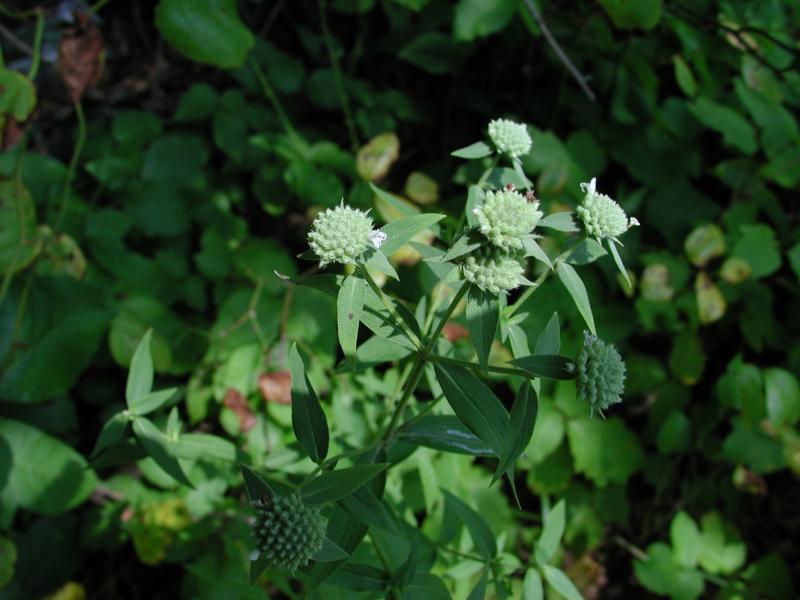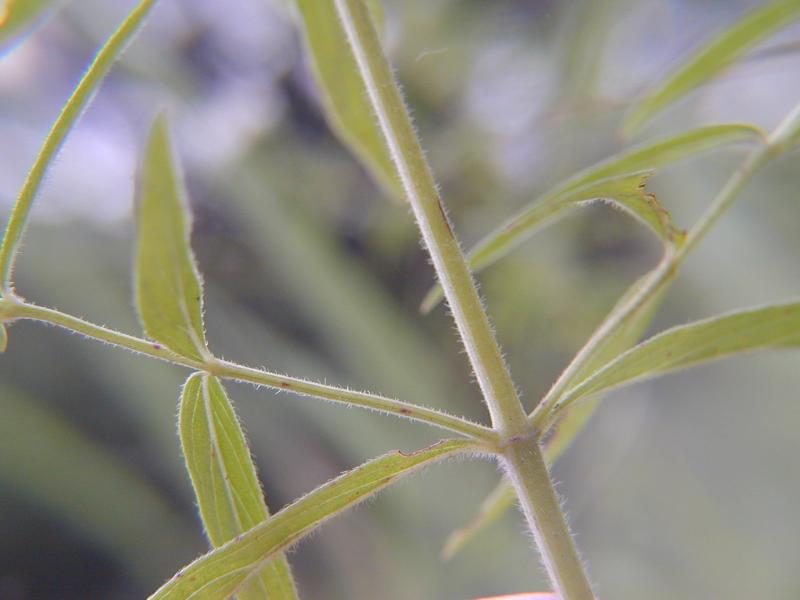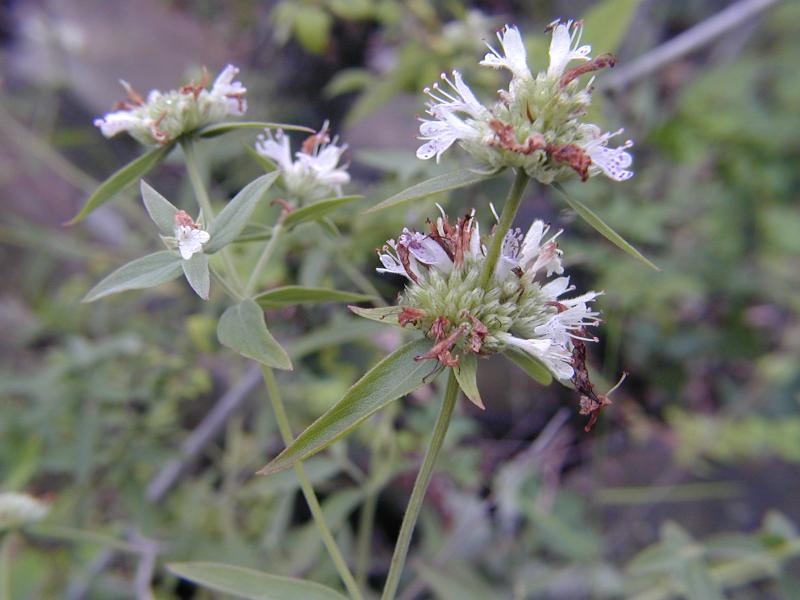Torrey's Mountain Mint
Pycnanthemum torreyi Benth.
- Class
- Dicotyledoneae (Dicots)
- Family
- Lamiaceae (Mint Family)
- State Protection
- Endangered
Listed as Endangered by New York State: in imminent danger of extirpation in New York. For animals, taking, importation, transportation, or possession is prohibited, except under license or permit. For plants, removal or damage without the consent of the landowner is prohibited.
- Federal Protection
- Not Listed
- State Conservation Status Rank
- S1
Critically Imperiled in New York - Especially vulnerable to disappearing from New York due to extreme rarity or other factors; typically 5 or fewer populations or locations in New York, very few individuals, very restricted range, very few remaining acres (or miles of stream), and/or very steep declines.
- Global Conservation Status Rank
- G2
Imperiled globally - At high risk of extinction due to rarity or other factors; typically 20 or fewer populations or locations in the world, very few individuals, very restricted range, few remaining acres (or miles of stream), and/or steep declines.
Summary
Did you know?
This species is named for John Torrey, the famous New york botanist who wrote the first Flora if New York in 1843. A recently discovered population on Staten Island was almost destroyed by the construction of a shopping center.
State Ranking Justification
There are three existing populations but all of them are small or highly threatened. Most of the eight historical records occur in areas that are highly developed in the New York City area and are considered extirpated. There is a slight possibility that a few historical records could be rediscovered or new populations found in protected areas in the Lower Hudson region.
Short-term Trends
The small existing populations are threatened by succession and by development.
Long-term Trends
This plant was never common in New York. Many of the historical records have been extirpated by development while a few new populations have been discovered. If these trends continue this species may not persist.
Conservation and Management
Threats
A roadside population is threatened by nearby development and road maintenance. Other populations could be threatened by succession of the open meadow community if areas were allowed to succeed to woody plants.
Conservation Strategies and Management Practices
Open areas need to be maintained without directly damaging plants. This can be done at the appropriate time of year after seed has been disbursed. Plants should be protected from direct destruction by habitat alteration.
Research Needs
Genetic studies should be performed on the populations to determine the relationship among populations in New York and among populations range wide. Genetic studies could also help separate this species from closely related species that also occur within its range. Habitat preference studies are needed to understand why this species is so restricted in distribution locally and range-wide.
Habitat
Habitat
In New York Torrey's Mountain Mint has been found in dry, open habitats, including red cedar barrens, rocky summits, trails, and roadsides (New York Natural Heritage Program 2007). Dry, often fertile, woods and thickets (Fernald 1970). Dry upland woods (Gleason & Cronquist 1991).
Associated Ecological Communities
- Appalachian oak-hickory forest
(guide)
A hardwood forest that occurs on well-drained sites, usually on ridgetops, upper slopes, or south- and west-facing slopes. The soils are usually loams or sandy loams. This is a broadly defined forest community with several regional and edaphic variants. The dominant trees include red oak, white oak, and/or black oak. Mixed with the oaks, usually at lower densities, are pignut, shagbark, and/or sweet pignut hickory.
- Limestone woodland*
(guide)
A woodland that occurs on shallow soils over limestone bedrock in non-alvar settings, and usually includes numerous rock outcrops. There are usually several codominant trees, although one species may become dominant in any one stand.
- Red cedar rocky summit
(guide)
A community that occurs on warm, dry, rocky ridgetops and summits where the bedrock is calcareous (such as limestone or dolomite, but also marble, amphibolite, and calcsilicate rock), and the soils are more or less calcareous. The vegetation may be sparse or patchy, with numerous lichen covered rock outcrops.
* probable association but not confirmed.
Associated Species
- Asclepias viridiflora (green milkweed)
- Betula papyrifera (paper birch)
- Bouteloua curtipendula
- Carex annectens (yellow fox sedge)
- Carex brevior (short-beaked sedge)
- Carex pensylvanica (Pennsylvania sedge)
- Carya glabra (pignut hickory)
- Corydalis sempervirens
- Cunila origanoides (American dittany)
- Danthonia compressa (northern oat grass)
- Danthonia spicata (poverty grass)
- Daucus carota (wild carrot)
- Desmodium paniculatum (panicled tick-trefoil)
- Erechtites hieraciifolia
- Eupatorium album
- Fallopia cilinodis (fringed bindweed)
- Gaylussacia baccata (black huckleberry)
- Helianthus decapetalus (thin-leaved sunflower)
- Hieracium venosum (rattlesnake hawkweed)
- Hypericum canadense (lesser Canadian St. John's-wort)
- Juniperus virginiana
- Liatris scariosa var. novae-angliae (New England blazing-star)
- Linum sulcatum (grooved yellow flax)
- Liquidambar styraciflua (sweet-gum)
- Onosmodium virginianum
- Ostrya virginiana (hop hornbeam, ironwood)
- Panicum virgatum (switch grass)
- Paronychia canadensis (smooth forked-chickweed)
- Parthenocissus quinquefolia (Virginia-creeper)
- Phragmites australis (old world reed grass, old world phragmites)
- Poa compressa (flat-stemmed blue grass, Canada blue grass)
- Potentilla simplex (old-field cinquefoil)
- Pycnanthemum clinopodioides (basil mountain-mint)
- Pycnanthemum incanum
- Pycnanthemum tenuifolium (narrow-leaved mountain-mint)
- Quercus montana (chestnut oak)
- Quercus palustris (pin oak)
- Quercus rubra (northern red oak)
- Rhus copallinum
- Rhus typhina (stag-horn sumac)
- Sassafras albidum (sassafras)
- Schizachyrium scoparium
- Smilax rotundifolia (common greenbrier)
- Solidago bicolor (silver-rod)
- Solidago juncea (early goldenrod)
- Sorghastrum nutans (Indian grass)
- Symphyotrichum patens
- Toxicodendron radicans
- Triodanis perfoliata (common Venus's looking-glass)
- Verbascum blattaria (moth mullein)
- Viburnum prunifolium (black-haw)
- Viburnum rafinesquianum
Range
New York State Distribution
This species is known only from Rockland and Dutchess Counties at the southern end of the state.
Global Distribution
Pycnanthemum torreyi reaches the northeastern limit of its current range in New York State (it is believed to have been extirpated from New Hampshire), and is found in the Atlantic states south as far as South Carolina. It is also found inland in Pennsylvania, West Virginia, Kentucky, and Tennessee. It is believed to have also been extirpated from Illinois and Missouri, but is present in Kansas. It is a species of conservation concern throughout most of its range.
Identification Comments
Best Life Stage for Proper Identification
Torrey's Mountain-mint is best identified when flowering or fruiting.
Similar Species
Pycnanthemum torrei most closely resembles P.verticillatum, from which it differs by its leaves and bracts being glabrous on the upper surface, (those of P. verticillatum evidently hairy above). P. torrei also has longer (1 to 1.5 mm) and sharper calyx teeth (those of P. verticillatum .5 to 1 mm long and triangular).
P. virginianum has stem pubescence confined to the stem angles, and P. tenuifolium has a glabrous stem, in contrast to the uniformly finely pubescent stems of Pycnanthemum torrei.
Best Time to See
This species flowers from mid-July through August, and the fruits persist to early October.
- Flowering
- Fruiting
The time of year you would expect to find Torrey's Mountain Mint flowering and fruiting in New York.
Torrey's Mountain Mint Images
Taxonomy
Torrey's Mountain Mint
Pycnanthemum torreyi Benth.
- Kingdom Plantae
- Phylum Anthophyta
- Class Dicotyledoneae
(Dicots)
- Order Lamiales
- Family Lamiaceae (Mint Family)
- Order Lamiales
- Class Dicotyledoneae
(Dicots)
- Phylum Anthophyta
Synonyms
- Koellia torrei (Benth.) Kuntze
- Pycnanthemum torrei Benth.
Comments on the Classification
This may be a hybrid which does not persist for long. Taxonomic work is needed.
Additional Resources
Best Identification Reference
Gleason, Henry A. and A. Cronquist. 1991. Manual of Vascular Plants of Northeastern United States and Adjacent Canada. The New York Botanical Garden, Bronx, New York. 910 pp.
Other References
Clemants, Steven and Carol Gracie. 2006. Wildflowers in the Field and Forest. A Field Guide to the Northeastern United States. Oxford University Press, New York, NY. 445 pp.
Fernald, M.L. 1950. Gray's manual of botany. 8th edition. D. Van Nostrand, New York. 1632 pp.
Grant, Elizabeth and Carl Epling. 1943. A study of Pycnanthemum (Labiatae). University Of California Publications in Botany 20: 195-240.
Holmgren, Noel. 1998. The Illustrated Companion to Gleason and Cronquist's Manual. Illustrations of the Vascular Plants of Northeastern United States and Adjacent Canada. The New York Botanical Garden, Bronx, New York.
New York Natural Heritage Program. 2010. Biotics database. New York Natural Heritage Program. New York State Department of Environmental Conservation. Albany, NY.
New York Natural Heritage Program. 2024. New York Natural Heritage Program Databases. Albany, NY.
Snyder, D.B. 1994. Additions, range extensions, reinstatements, and relocations in the New Jersey flora. Bartonia 58: 79-96.
Weldy, T. and D. Werier. 2010. New York flora atlas. [S.M. Landry, K.N. Campbell, and L.D. Mabe (original application development), Florida Center for Community Design and Research http://www.fccdr.usf.edu/. University of South Florida http://www.usf.edu/]. New York Flora Association http://newyork.plantatlas.usf.edu/, Albany, New York
Weldy, Troy W. and David Werier. 2005. New York Flora Atlas. [S.M. Landry, K.N. Campbell, and L.D. Mabe (original application development), Florida Center for Community Design and Research. University of South Florida]. New York Flora Association, Albany, NY. Available on the web at (http://newyork.plantatlas.usf.edu/).
Links
About This Guide
Information for this guide was last updated on: December 22, 2008
Please cite this page as:
New York Natural Heritage Program. 2024.
Online Conservation Guide for
Pycnanthemum torreyi.
Available from: https://guides.nynhp.org/torreys-mountain-mint/.
Accessed July 27, 2024.


